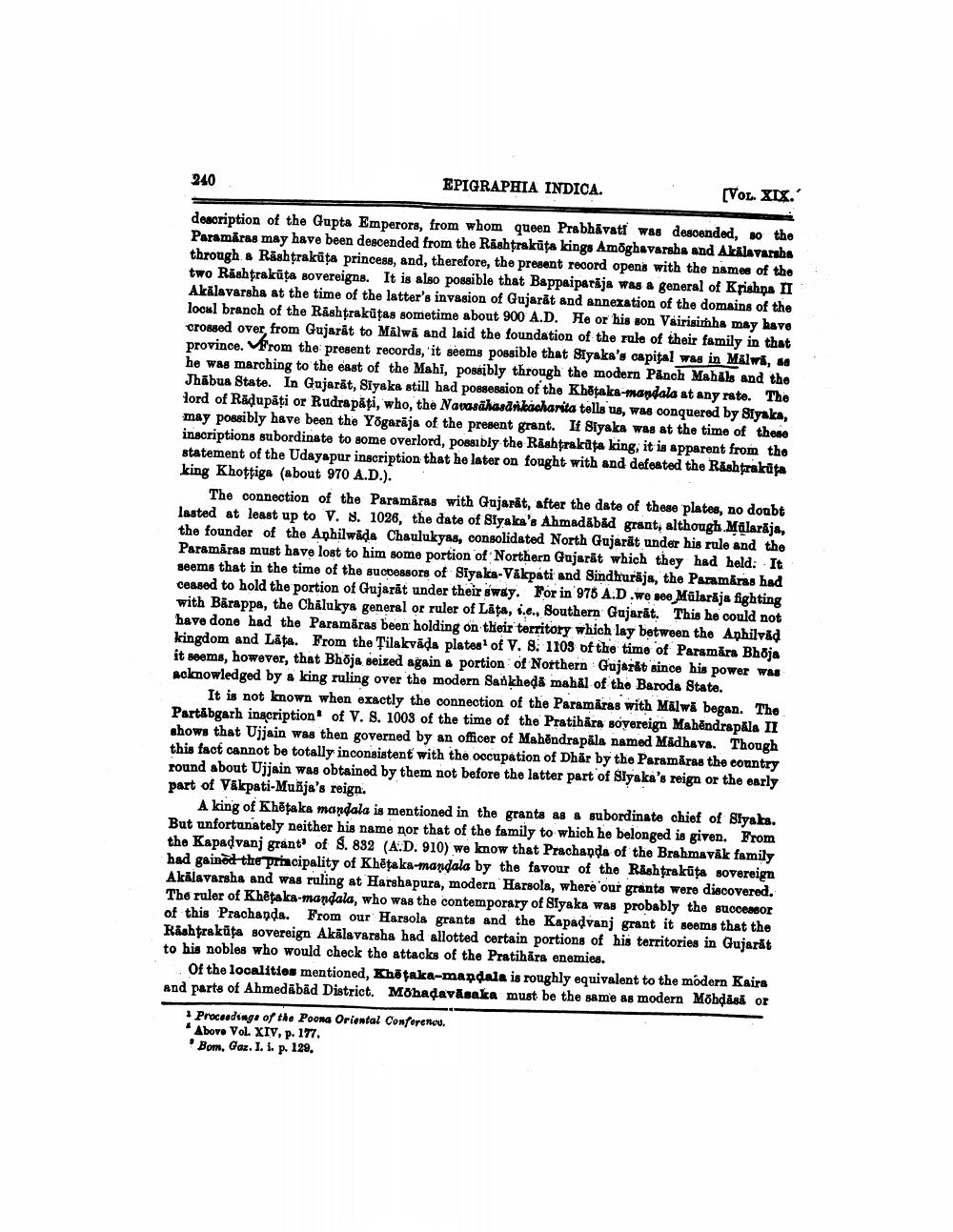________________
EPIGRAPHIA INDICA.
[VOL. XIX.
description of the Gupta Emperors, from whom queen Prabhavati was descended, so the Paramaras may have been descended from the Rashtrakuta kings Amöghavarsha and Akalavarsha through a Rashtrakuta princess, and, therefore, the present record opens with the names of the two Rashtrakuta sovereigns. It is also possible that Bappaiparaja was a general of Krishna II Akälavarsha at the time of the latter's invasion of Gujarat and annexation of the domains of the local branch of the Rashtrakutas sometime about 900 A.D. He or his son Vairisimha may have crossed over, from Gujarat to Malwa and laid the foundation of the rule of their family in that province. From the present records, it seems possible that Siyaka's capital was in Malwa, as he was marching to the east of the Mahi, possibly through the modern Panch Mahals and the Jhabua State. In Gujarat, Siyaka still had possession of the Khataka-mandala at any rate. The lord of Rădupăți or Rudrapați, who, the Navasahasdnikacharita tells us, was conquered by Siyaka, may possibly have been the Yogaraja of the present grant. If Siyaka was at the time of these inscriptions subordinate to some overlord, possibly the Rashtrakuta king, it is apparent from the statement of the Udayapur inscription that he later on fought with and defeated the Rashtrakuta king Khottiga (about 970 A.D.).
240
The connection of the Paramaras with Gujarat, after the date of these plates, no doubt lasted at least up to V. S. 1026, the date of Siyaka's Ahmadābād grant, although Mälarāja, the founder of the Aphilwada Chaulukyas, consolidated North Gujarat under his rule and the Paramāras must have lost to him some portion of Northern Gujarat which they had held: It seems that in the time of the successors of Siyaka-Vakpati and Sindhuraja, the Paramāras had ceased to hold the portion of Gujarat under their sway. For in 975 A.D.we see Mülaraja fighting with Bärappa, the Chalukya general or ruler of Lata, i.e., Southern Gujarat. This he could not have done had the Paramaras been holding on their territory which lay between the Aphilväd kingdom and Lata. From the Tilakvada plates1 of V. S. 1103 of the time of Paramara Bhoja it seems, however, that Bhoja seized again a portion of Northern Gujarat since his power was acknowledged by a king ruling over the modern Sankheda mahal of the Baroda State.
It is not known when exactly the connection of the Paramaras with Malwa began. The Partabgarh inscription of V. S. 1003 of the time of the Pratihara sovereign Mahendrapala II shows that Ujjain was then governed by an officer of Mahendrapala named Madhava. Though this fact cannot be totally inconsistent with the occupation of Dhar by the Paramaras the country round about Ujjain was obtained by them not before the latter part of Slyaka's reign or the early part of Vakpati-Muñja's reign.
A king of Khotaka mandala is mentioned in the grants as a subordinate chief of Siyaka. But unfortunately neither his name nor that of the family to which he belonged is given. From the Kapadvanj grant of S. 832 (A.D. 910) we know that Prachanda of the Brahmavak family had gained the principality of Khêṭaka-mandala by the favour of the Rashtrakuta sovereign Akalavarsha and was ruling at Harshapura, modern Harsola, where 'our grants were discovered. The ruler of Khetaka-mandala, who was the contemporary of Siyaka was probably the successor of this Prachanda. From our Harsola grants and the Kapadvanj grant it seems that the Rashtrakuta sovereign Akälavarsha had allotted certain portions of his territories in Gujarat to his nobles who would check the attacks of the Pratihära enemies.
Of the localities mentioned, Khotaka-mandala is roughly equivalent to the modern Kaira and parts of Ahmedabad District. Möhaḍavāsaka must be the same as modern Möhḍäsä or
1 Proceedings of the Poona Oriental Conference.
Above Vol. XIV, p. 177.
Bom, Gaz. I. i. p. 129.




